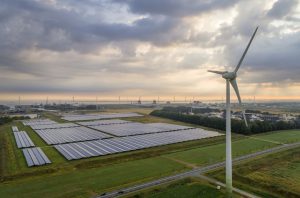The world is heading closer to its goal of tripling renewable energy capacity and cutting down fossil fuel use by 2030, the International Energy Agency has said in a new report.
“The goal of tripling global renewable energy capacity by 2030 is within reach thanks to favourable economics, ample manufacturing potential and strong policies,” the IEA said in the report released on Tuesday.
But the agency also cautioned that reaching the goal will “hinge on additional international efforts to set the right enabling conditions.”
Also on AF: Online Misinformation Harming Climate Change Effort, UN Chief Says
“To ensure the world doesn’t miss this huge opportunity, the focus must shift rapidly to implementation,” IEA executive director Fatih Birol said.
The goal to triple renewable energy capacity by 2030, and also double the rate of energy efficiency, was adopted by nearly 200 countries at the COP28 in Dubai last December.
The IEA said its report aims to set out guidelines for global economies on how to increase renewables in their energy mix in a manner necessary to reach the goal. The report, titled “From Taking Stock to Taking Action,” comes ahead of COP29, which is set to be held in Baku, Azerbaijan in November.
“In most countries the potential for renewable energy is larger than total electricity demand, and in many instances, it is far higher,” according to the report.
Fully achieving the COP28 goals for renewables and efficiency would cut global emissions by 10 billion tonnes by 2030, it added.
Booming solar
To triple renewables capacity, the world will need to boost total installed capacity of all renewable energy technologies in the electricity sector from 3,680 gigawatts (GW) in 2022 to around 11,500 GW in 2030, according to the report.
To achieve this goal, almost 1,000 GW of new renewables capacity must be added on average per year from 2023 to 2030, it added.
The total renewables capacity added globally in 2023 — a record high — was about half of that requirement, at 560 GW.
Solar photovoltaic (PV) alone accounted for three-quarters of all new renewables capacity in 2023, the IEA noted.
That boom in solar PV is expected to continue this year.
The world is expected to add 593 GW of solar capacity alone this year, according to estimates from energy think tank Ember. That would mean solar energy alone would account for more than half of the renewables capacity required to meet the 2030 goals.
Improving energy storage and grids
That tremendous growth, however, will not automatically translate into better capacity.
“Greater capacity does not automatically mean that more renewable electricity will clean up the world’s power systems, lower costs for consumers and slash fossil fuel use,” IEA noted.
Global economies will need to make “a concerted push to build and modernise 25 million kilometres of electricity grids by 2030,” the IEA said.
The world will also need 1500 gigawatts (GW) of energy storage capacity by 2030, of which 1,200 GW will need to come from battery storage, IEA said. That would mark a 15-fold increase on today’s level, it added.
The energy mix challenge
While booming solar growth is good news, an energy mix skewed towards it may not necessarily be ideal for the 2030 energy efficiency goals.
A key challenge is that solar PV produces electricity only during the day. As a result, over the course of the year, it generates only about half as much electricity as wind power per unit of capacity, according to the IEA.
Despite that, wind power capacity has struggled due to higher interest rates and supply chain tensions — such as the crackdown by the US and EU on China-made wind imports.
The IEA noted solar PV manufacturing was fast approaching the levels needed for COP28 goals. But other renewable energy technologies are not yet on track to reach their required levels.
Fixing this would be necessary as “a portfolio of various renewable energy technologies will often help countries to meet electricity demand in a secure and affordable way,” the IEA report said.
- Vishakha Saxena
Also read:
Global Wind Turbine Demand Soars on China Energy Push
Electrification Cuts Oil, Gas Production Emissions by 80%
Green Investment Hindered by Poor Demand For Low-Carbon Products
Governments Spend $2.6tn on Climate-Harming Support – Guardian
Oil And Gas Sector Way Off Net Zero Track: S&P Global
Oil Nations Blocking COP29 Efforts on Fossil Fuel Phaseout – FT
























